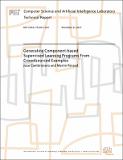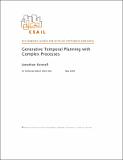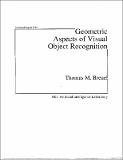Browsing Computer Science and Artificial Intelligence Lab (CSAIL) by Title
Now showing items 1398-1417 of 3804
-
Generalized Organization of Large Data Bases: A Set-theoretic Approach to Relations
(1970-06)Problems inherent in representation and manipulation of large data bases are discussed. Data management is considered as the manipulation of relationships among elements of a data base. A detailed analogy introduces ... -
Generalized Planar Matching
(1985-04)In this paper, we prove that maximum planar H-matching (the problem of determining the maximum number of node-disjointed copies of the fixed graph H contained in a variable planar graph G) is NP-complete for any connected ... -
The Generalized Railroad Crossing: A Case Study in Formali Verification of Real-time Systems
(1994-11)A new solution to the Generalized Railroad Crossing problem, based on timed automata, invariants and simulation mappings, is presented and evaluated. The solution shows formally the correspondence between four system ... -
Generalizing on Multiple Grounds: Performance Learning in Model-Based Technology
(1989-02-01)This thesis explores ways to augment a model-based diagnostic program with a learning component, so that it speeds up as it solves problems. Several learning components are proposed, each exploiting a different kind ... -
Generating and Generalizing Models of Visual Objects
(1985-07-01)We report on initial experiments with an implemented learning system whose inputs are images of two-dimensional shapes. The system first builds semantic network descriptions of shapes based on Brady's smoothed local ... -
Generating Circuit Tests by Exploiting Designed Behavior
(1988-12-01)This thesis describes two programs for generating tests for digital circuits that exploit several kinds of expert knowledge not used by previous approaches. First, many test generation problems can be solved efficiently ... -
Generating Communications Systems Through Shared Context
(2002-01-01)In a distributed model of intelligence, peer components need to communicate with one another. I present a system which enables two agents connected by a thick twisted bundle of wires to bootstrap a simple communication ... -
Generating Compliant Motion of Objects with an Articulated Hand
(1985-06-01)The flexibility of the robot is the key to its success as a viable aid to production. Flexibility of a robot can be explained in two directions. The first is to increase the physical generality of the robot such that ... -
Generating Component-based Supervised Learning Programs From Crowdsourced Examples
(2017-12-21)We present CrowdLearn, a new system that processes an existing corpus of crowdsourced machine learning programs to learn how to generate effective pipelines for solving supervised machine learning problems. CrowdLearn uses ... -
Generating Semantic Description from Drawings of Scenes with Shadows
(MIT Artificial Intelligence Laboratory, 1972-11)The research reported here concerns the principles used to automatically generate three-dimensional representations from line drawings of scenes. The computer programs involved look at scenes which consist of polyhedra and ... -
Generating Semantic Descriptions From Drawings of Scenes With Shadows
(1972-11-01)The research reported here concerns the principles used to automatically generate three-dimensional representations from line drawings of scenes. The computer programs involved look at scenes which consist of polyhedra ... -
Generating Trees of (Reducible) 1324-avoiding Permutations
(2003-10-09)We consider permutations that avoid the pattern 1324. We give exact formulas for thenumber of reducible 1324-avoiding permutations and the number of {1324, 4132, 2413, 3241}-avoiding permutations. By studying the generating ... -
Generative Temporal Planning with Complex Processes
(2004-05-18)Autonomous vehicles are increasingly being used in mission-critical applications, and robust methods are needed for controlling these inherently unreliable and complex systems. This thesis advocates the use of model-based ... -
Generative Temporal Planning with Complex Processes
(2004-05-18)Autonomous vehicles are increasingly being used in mission-critical applications, and robust methods are needed for controlling these inherently unreliable and complex systems. This thesis advocates the use of model-based ... -
Generic Software for Emulating Multiporocessor Architectures
(1985-05)The expense of designing, prototyping, and testing a new computer architecture (particularly non-traditional supercomputer architectures, such as the dataflow machine) is enormous. The relative inflexibility of hardware ... -
Genetic AI: Translating Piaget into Lisp
(1986-02-01)This paper presents a constuctivist model of human cognitive development during infancy. According to constructivism, the elements of mental representation -- even such basic elements as the concept of physical object ... -
The Genetic Epistemology of Rule Systems
(1978-01-01)I shall describe a model of the evolution of the rule-structured knowledge that serves as a cornerstone of our development of computer-based coaches. The key idea is a graph structure whose nodes represent rules, and ... -
Geometric and Algebraic Aspects of 3D Affine and Projective Structures from Perspective 2D Views
(1993-07-01)We investigate the differences --- conceptually and algorithmically --- between affine and projective frameworks for the tasks of visual recognition and reconstruction from perspective views. It is shown that an affine ... -
Geometric Aspects of Visual Object Recognition
(1992-05-01)This thesis presents there important results in visual object recognition based on shape. (1) A new algorithm (RAST; Recognition by Adaptive Sudivisions of Tranformation space) is presented that has lower average-case ... -
Geometric Structure of the Adaptive Controller of the Human Arm
(1993-07-01)The objects with which the hand interacts with may significantly change the dynamics of the arm. How does the brain adapt control of arm movements to this new dynamic? We show that adaptation is via composition of a ...



















